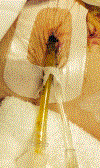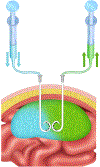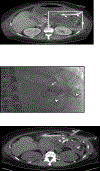Paired Drainage Catheter Insertion: Feasibility of Placing Two Catheters within the Same Complex Abscess Cavity as a Primary and Salvage Percutaneous Drainage Technique
- PMID: 31031185
- PMCID: PMC6814525
- DOI: 10.1016/j.acra.2019.03.010
Paired Drainage Catheter Insertion: Feasibility of Placing Two Catheters within the Same Complex Abscess Cavity as a Primary and Salvage Percutaneous Drainage Technique
Abstract
Rationale and objectives: To assess the feasibility of paired catheter drainage for management of complex abdominal abscesses.
Materials and methods: This was a single-center retrospective study of 54 patients (35 males; mean age 48.9 years) that underwent paired catheter insertion for complex abdominal fluid collections in an 18-month period. Complex collections were defined as abscesses ≥6 cm in diameter with septations, high viscosity fluid or necrotic debris, or abscesses with an associated fistula. Abscess etiologies included postoperative (n = 28), pancreatitis (n = 12), perforated bowel (n = 7), liver abscess (n = 4), and perihepatic from gallbladder perforation (n = 3). Paired catheter insertion was defined two catheters co-located within one collection through the same skin incision or two closely spaced insertion sites. Paired catheter insertion was used primarily as initial drainage for complex intraabdominal abscesses and for salvage drainage in collections that could not be evacuated by a single catheter. Primary paired catheter insertion was used in 45 patients and as salvage in nine patients.
Results: Abscess resolution occurred in 51 (94.4%) patients. Patients had a median of three drainage procedures. Median duration of paired catheterization was 22 days. Seven abscesses recurred and all resolved with repeated drainage. Complications included one hemorrhage that was taken for surgical exploration. Overall, 48 patients had good clinical outcome, 3 patients died (multiorgan failure, n = 2; sepsis, n = 1), and 3 patients were lost to follow-up.
Conclusion: Percutaneous paired catheter drainage is a feasible technique for the treatment of both complex intraabdominal abscesses and abscesses unresponsive to single catheter drainage.
Keywords: Abdominal abscess; Abscess drainage; Drainage catheter; Image-guided percutaneous drainage; Intraabdominal abscess; Paired catheters.
Copyright © 2019 The Association of University Radiologists. Published by Elsevier Inc. All rights reserved.
Conflict of interest statement
Figures





Similar articles
-
Abscess-Fistula Complexes: A Systematic Approach for Percutaneous Catheter Management.J Vasc Interv Radiol. 2015 Sep;26(9):1363-7. doi: 10.1016/j.jvir.2015.06.030. J Vasc Interv Radiol. 2015. PMID: 26314645
-
Liver Abscesses: Factors That Influence Outcome of Percutaneous Drainage.AJR Am J Roentgenol. 2017 Jul;209(1):205-213. doi: 10.2214/AJR.16.17713. Epub 2017 May 15. AJR Am J Roentgenol. 2017. PMID: 28504550
-
Percutaneous treatment of liver abscesses: needle aspiration versus catheter drainage.AJR Am J Roentgenol. 1998 Apr;170(4):1035-9. doi: 10.2214/ajr.170.4.9530055. AJR Am J Roentgenol. 1998. PMID: 9530055 Clinical Trial.
-
Interventional and surgical treatment of pancreatic abscess.World J Surg. 1997 Feb;21(2):162-8. doi: 10.1007/s002689900209. World J Surg. 1997. PMID: 8995072 Review.
-
Percutaneous, computed tomography-guided drainage of deep pelvic abscesses via a transgluteal approach: a report on 30 cases and a review of the literature.Abdom Imaging. 2013 Apr;38(2):285-9. doi: 10.1007/s00261-012-9917-z. Abdom Imaging. 2013. PMID: 22684488 Review.
References
-
- Jaffe TA, Nelson RC, Delong DM, Paulson EK. Practice patterns in percutaneous image-guided intraabdominal abscess drainage: survey of academic and private practice centers. Radiology 2004;233:750–756. - PubMed
-
- Levin DC, Eschelman D, Parker L, Rao VM. Trends in Use of Percutaneous Versus Open Surgical Drainage of Abdominal Abscesses. J Am Coll Radiol 2015;12:1247–1250. - PubMed
-
- vanSonnenberg E, Mueller PR, Ferrucci JT. Percutaneous drainage of 250 abdominal abscesses and fluid collections. Part I: Results, failures, and complications. Radiology 1984;151:337–341. - PubMed
-
- Mueller PR, vanSonnenberg E, Ferrucci JT. Percutaneous drainage of 250 abdominal abscesses and fluid collections. Part II: Current procedural concepts. Radiology 1984;151:343–347. - PubMed
-
- Wallace MJ, Chin KW, Fletcher TB, et al. Quality improvement guidelines for percutaneous drainage/aspiration of abscess and fluid collections. J Vasc Interv Radiol 2010;21:431–435. - PubMed
Publication types
MeSH terms
Grants and funding
LinkOut - more resources
Full Text Sources
Medical

